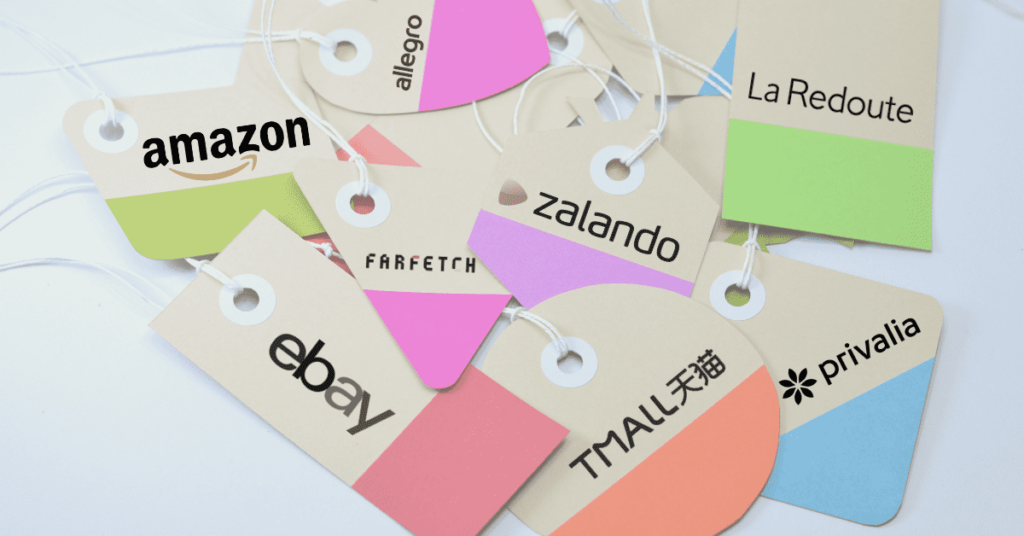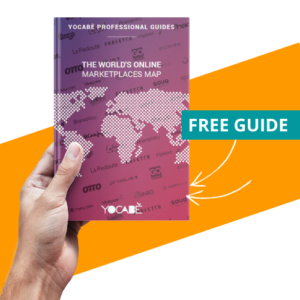What are marketplaces? And why is it important to take them into account in your online sales strategy?
Marketplaces are virtual spaces connecting retailers and brands to millions of potential customers. Amazon, eBay, Zalando are just a few famous examples.
While e-commerce is the brand’s digital showcase, marketplaces are a kind of digital shopping malls, where users browse through thousands of products from many brands and categories.
In 2018, 50% of online sales took place through marketplaces and this share is expected to grow by two thirds within 5 years. (source: webretailer)
There are two kinds of marketplaces:
- Vertical: platforms specialized in only one kind of product category (e.g. clothing and accessories).
- Horizontal: platforms offering many categories of products
Why selling on marketplaces?
To boost online sales, covering marketplaces can be an effective choice. Research shows that more and more users regularly buy on these platforms.
It happens for three main reasons:
- wide selection of products
- recurrent promotions and affordable prices
- fast shipments
Companies selling through marketplaces benefits from at least five advantages:
1. Reaching a wider audience
The marketplaces are well positioned on search engines. Thus, they are easily accessible to millions of visitors, more and more familiar with the direct search for the item on the marketplace website, e.g. through Zalando or eBay.
If in 2015 54% of product’s online search came from Google (and 31% from Amazon), now the situation has completely changed in favor of Bezos’ marketplace.
2. Catching traffic at a lower cost
Compared to the resources necessary to bring out one’s own e-commerce (for example through SEO activities, Pay per Click campaigns, social media), reaching a wide audience through marketplaces is cheaper on average.
3. Intercepting the latent demand
Through marketplaces it is possible to search by products, as well as by brand. This increases the probability of being found even by those who are looking for a specific product but do not know (yet) the brand.
4. EMPTYING THE WAREHOUSE
Affordable prices are among the reasons why users continue visiting marketplaces. Reaching a wide audience through marketplaces is an effective strategy to get rid of inventory.
5. STUDYING THE NEEDS OF YOUR OWN AUDIENCE
Selling through marketplaces is an effective way to quickly identify the most wanted products, study competitors’ prices and strategies and then adjust the offer. Furthermore, this kind of strategy reduces risks linked to the launch of new products.
How to sell on marketplaces
There are three strategies to sell on marketplaces:
- Selling as a Vendor. In this case, the brand sells part of its products to the marketplace, as if the platform was a retailer (online). Usually the brand sells these products at wholesale price, resulting in narrower margins.
- Selling as a Seller. It is a good option for some marketplaces, such as Amazon or eBay. In this case, brands take advantage of marketplaces to create a link with potential customers. In most cases it is necessary to deal with the creation of digital contents, shipments, bureaucracy, customer service and returns. As can be easily understood, selling as a Seller involves specific skills and dedicated resources.
- Relying on a specialized seller. In this case, the brands cooperate with a specialized partner who has the technology, skills, tax requirements and know-how to boost the penetration on marketplaces.
The most common mistakes
Including marketplaces in your sales strategy requires competence and experience. If you don’t know the related mechanisms, languages and rules, you run the risk of making mistakes and wasting resources.
The four 4 most common missteps of beginners are:
-
PUBLISHING INCOMPLETE OR NOT OPTIMIZED PRODUCT PAGES
The product page must provide the user with clear and complete info. Therefore, it needs a title indicating the brand, the product kind, the main function and, not less important, keywords that help users to find the item. The product page must also include appropriate descriptions and high-quality images matching the item.
-
ROUGH INVENTORY MANAGEMENT
It is essential that your inventory is continuously updated: if an item is not available, it must not be published. The risk is to generate a bad user experience, with obvious consequences on the seller’s reputation.
-
UNDERESTIMATING THE CUSTOMER SERVICE
Responding to a customer within 24 hours, communicating in the country language where the transaction takes place, meeting deadlines and providing clear information are just some of the good customer service practices that brands and retailers must take into account. In most marketplaces (e.g. Amazon) these activities strongly impact the ranking of the seller.
-
SELLING AT TOO LOW A PRICE
It may happen that the overall cost of selling through marketplaces is underestimated. A common mistake is not considering the commissions to be paid, as well as shipping or logistic costs (in case you join specific programs such as Amazon’s FBA, eBay’s Guaranteed Delivery eBay, etc.).
Main marketplaces
Depending on the business goals and the related product category, brands today can choose from many marketplaces, among them:
- Amazon is the today’s dominant selling online platform, as well as the most valuable brand in the world. It has 235 million items and 304 million registered users in over 180 countries.
- Zalando is a vertical platform focused only on the sale of clothing, shoes and accessories. It operates in 15 countries.
- Ebay is among the 10 most visited websites in the world. It offers 1 billion products from several categories and operates in 24 countries.
- Privalia (now Veepee) is an online fashion and lifestyle outlet offering limited-time promotions to 24 million registered customers.
- Spartoo is a French marketplace that takes its name from the shoes used by gladiators. It is mainly focused on footwear and clothing.
- Otto is a generalist German marketplace operating in over 30 countries.
- Cdiscount is among the most important French e-commerce websites. It is a horizontal platform, which embraces many product categories.
- Allegro is the first Polish marketplace and the fifth in Europe. It records 16 million users and offers over 20 million items, including clothing, home furnishings and products for children and sports.
- La Redoute, a French company based in Roubaix and Paris, is specialized in clothing sale, and is currently present in 26 countries.
- Farfetch is the world’s largest global luxury fashion marketplace.
- com is the Chinese equivalent of Amazon. Together with Tmall, it controls over 80% of Chinese online sales.
- Tmall is a Chinese marketplace focused on high quality products belonging to clothing, personal care, home furnishings and food.
Some successful stories
There are many stories of small and large companies that have grown thanks to the marketplaces digital showcases. With the appropriate strategy, marketplaces offer many opportunities to well-known brands and also to emerging businesses.
This is the case of Luisa Masciello, a former company manager with a passion for needlework who invented the “walking bibs”, a line of hand-sewn baby accessories. Today this passion has turned into a real company: ZigoZago, which owes much of its sales volume to e-commerce.
From the exclusively offline distribution to the top of the world’s No. 1 e-commerce. This is what happened to Premamy (GC brand), which has overcome the limits of traditional distribution thanks to marketplaces. Today its maternity clothes are at the top of the Amazon ranking in this category.
Amazon has also given a boost to Cristian Zanatta, a Romagna entrepreneur in sportswear, who, thanks to marketplaces, now distributes throughout all Europe.



